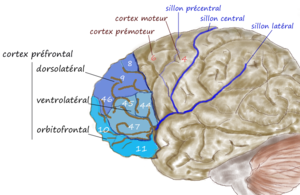
Back قشرة الفص الجبهي الظهراني Arabic Corteza dorsolateral prefrontal Spanish قشر خلفیجانبی پیشپیشانی Persian קליפת המוח הקדם-מצחית הגבית-צדית HE 背外側前頭前野 Japanese Dorsolaterale prefrontale cortex Dutch Дорсолатеральная префронтальная кора Russian Dorsolaterala prefrontalkortex Swedish Дорсолатеральна префронтальна кора Ukrainian 背外侧前额叶皮质 WUU
| Dorsolateral prefrontal cortex | |
|---|---|
 An illustration of brain's prefrontal region | |
| Details | |
| Identifiers | |
| Latin | cortex praefrontalis dorsolateralis |
| MeSH | D000087643 |
| FMA | 276189 |
| Anatomical terms of neuroanatomy | |
The dorsolateral prefrontal cortex (DLPFC or DL-PFC) is an area in the prefrontal cortex of the primate brain. It is one of the most recently derived parts of the human brain. It undergoes a prolonged period of maturation which lasts into adulthood.[1] The DLPFC is not an anatomical structure, but rather a functional one. It lies in the middle frontal gyrus of humans (i.e., lateral part of Brodmann's area (BA) 9 and 46[2]). In macaque monkeys, it is around the principal sulcus (i.e., in Brodmann's area 46[3][4][5]). Other sources consider that DLPFC is attributed anatomically to BA 9 and 46[6] and BA 8, 9 and 10.[1]
The DLPFC has connections with the orbitofrontal cortex, as well as the thalamus, parts of the basal ganglia (specifically, the dorsal caudate nucleus), the hippocampus, and primary and secondary association areas of neocortex (including posterior temporal, parietal, and occipital areas).[7][8] The DLPFC is also the end point for the dorsal pathway (stream),[9] which is concerned with how to interact with stimuli.
An important function of the DLPFC is the executive functions, such as working memory, cognitive flexibility,[10] planning, inhibition, and abstract reasoning.[11] However, the DLPFC is not exclusively responsible for executive functions. All complex mental activity requires the additional cortical and subcortical circuits with which the DLPFC is connected.[12] The DLPFC is also the highest cortical area that is involved in motor planning, organization and regulation.[12]
- ^ a b Charles A. Nelson; Monica Luciana, eds. (2001). Handbook of developmental cognitive neuroscience. Cambridge, Mass. [u.a.]: MIT Press. pp. 388–392. ISBN 978-0-262-14073-7.
- ^ Brodmann, 1909
- ^ Walker, 1940
- ^ Hoshi, E. (2001). "Functional specialization within the dorsolateral prefrontal cortex: a review of anatomical and physiological studies of non-human primates". Neuroscience Research. 54 (2): 73–84. doi:10.1016/j.neures.2005.10.013. PMID 16310877. S2CID 17212229.
- ^ Mylius, V. (2013). "Definition of DLPFC and M1 according to anatomical landmarks for navigated brain stimulation: inter-rater reliability, accuracy, and influence of gender and age". NeuroImage. 78: 224–32. doi:10.1016/j.neuroimage.2013.03.061. PMID 23567888. S2CID 1535066.
- ^ Cieslik, E. (2013). "Is There "One" DLPFC in Cognitive Action Control? Evidence for Heterogeneity From Co-Activation-Based Parcellation". Cerebral Cortex. 23 (11): 2677–2689. doi:10.1093/cercor/bhs256. PMC 3792742. PMID 22918987.
- ^ Baldauf, D.; Desimone, R. (2014-04-25). "Neural Mechanisms of Object-Based Attention". Science. 344 (6182): 424–427. Bibcode:2014Sci...344..424B. doi:10.1126/science.1247003. ISSN 0036-8075. PMID 24763592. S2CID 34728448.
- ^ Moss, Simmon. "Dorsolateral Prefrontal Cortex". Psychlopedia. Archived from the original on 11 November 2013. Retrieved 11 November 2013.
- ^ Takahashi, Emi; Ohki, Kenichi; Kim, Dae-Shik (2013-01-15). "Dissociation and Convergence of the Dorsal and Ventral Visual Streams in the Human Prefrontal Cortex". NeuroImage. 65: 488–498. doi:10.1016/j.neuroimage.2012.10.002. ISSN 1053-8119. PMC 4384683. PMID 23063444.
- ^ Kaplan, J. T.; et al. (2016). "Neural correlates of maintaining one's political beliefs in the face of counterevidence". Scientific Reports. 6. Nature: 39589. Bibcode:2016NatSR...639589K. doi:10.1038/srep39589. PMC 5180221. PMID 28008965.
- ^ Cite error: The named reference
humanfrontallobeswas invoked but never defined (see the help page). - ^ a b James B. Hale; Catherine A. Fiorello (2004). School neuropsychology: A Practitioner's Handbook. Guilford Press. pp. 64–65. ISBN 978-1593850111.